
China citrus study tour report
Andrew Creek, NSW Department of Primary Industries Citrus Development Officer
Helen Chen and Cecelia Fu (NSW DPI International Engagement) and Andrew Creek, (NSW DPI Development Officer Citrus) recently assisted a Griffith delegation of export accredited packing facilities and China certified citrus growers. Their mission to see part of the Chinese citrus industry was financially supported by Austrade and Griffith and District Citrus Growers Association (G&DCG).
The December 2019 tour group saw high and middle-end retail store distribution options, experienced wholesale fruit markets and met with Chinese importers. China’s domestic orange production was seen, and fruit handling and packaging systems were also visited. After the tour, the delegation understood different sales channels and strengthened their relationships with Chinese importers.
Key recommendations
- The industry must adopt research-based preharvest and postharvest best practice to enable export of sweeter and lower acid oranges to China.
- Riverina packers should work together to build a single regional brand, rather than competing with different brands that Chinese consumers do not recognise.
- Australian brands must provide the Chinese consumer with a consistently good eating experience as new market competitors like Chile have the opportunity to gain market share at Australian expense.
- The industry must ensure our food safety systems remain strong to maintain the competitiveness of Australian citrus in export markets.
Travel Itinerary
- City Super – high-end retail store tour and meet with operations manager.
- Austrade Shanghai office – China citrus market brief.
- A Pagoda Fruit chain store and the Pagoda – Shanghai fruit logistic delivery hub. Middle-end retail store visit and logistic hub tour to see the supply chain and discussion with Pagoda purchasing team.
- City Shop – middle-end retail store visit and discussion with the purchasing team.
- Hema Fresh retail store – tour a modern retail store design that also uses the Alibaba e-commerce platform. Discussion with Hema Fresh citrus purchasing manager.
- Nongfu Spring – Anyuan citrus packing house to learn navel orange product quality specifications.
- Anyuan citrus orchards – Newhall navel orange production and Hamlin juice orange production. Meet and discussion with orchard managers and Nongfu Spring Grower Services team.
- Nongfu Spring – Xinfeng citrus packaging lines and juice factory. Tour and discussion with Nongfu Spring Agribusiness team.
- China Gannan Navel Orange Industrial Park to learn history of citrus in China – soils, citrus varieties, modern crop nutrition, pest monitoring, product traceability system to prevent product fraud and Nongfu Spring vision for 17.5o Australian citrus.
- Reemoon Technology Holdings Co. Ltd. – Tour manufacturing facility of electronic fruit grading – NIR, Brix and acid developments. Visit Reemoon’s citrus research farm.
- National Navel Orange Engineering Research Centre (NORC) – meet Vice Director NORC – visit USA and China HLB, Canker and Asiatic Citrus Psyllid research centre.
- Shanghai Huizhan Fruit Wholesale Market – site visit. Shanghai Huizhan International Trading Co. Ltd. - market access training on imported citrus and China customs clearance. Roundtable meeting with key citrus importers.
General Observations
Meetings, discussion and briefings from Austrade and each of the key visits demonstrated that Chinese consumers prefer juicy, fully coloured, sweet and low acid citrus fruit (minimum 12 Brix and maximum 0.65 % acid). Taste was the most important factor for a consumer choosing to repeat purchase a brand.
Discussion with fruit chain purchase managers and importers showed distributors had different preferences for navel orange fruit sizing. Most Chinese importers preferred C6 (18 kg net weight carton) count size 72 yet were happy to sell sizes 80 to 100. They indicated caution with the larger sized fruit as in the past, they had more internal dryness or granulation.
In both fruit retail shops and supermarkets, fruit with composite grade appearance (blemish) with a guaranteed sweetness brand was selling at a higher price than early domestic Newhall navel orange and also perfectly presented late imported Australian navel orange (Figure 1).
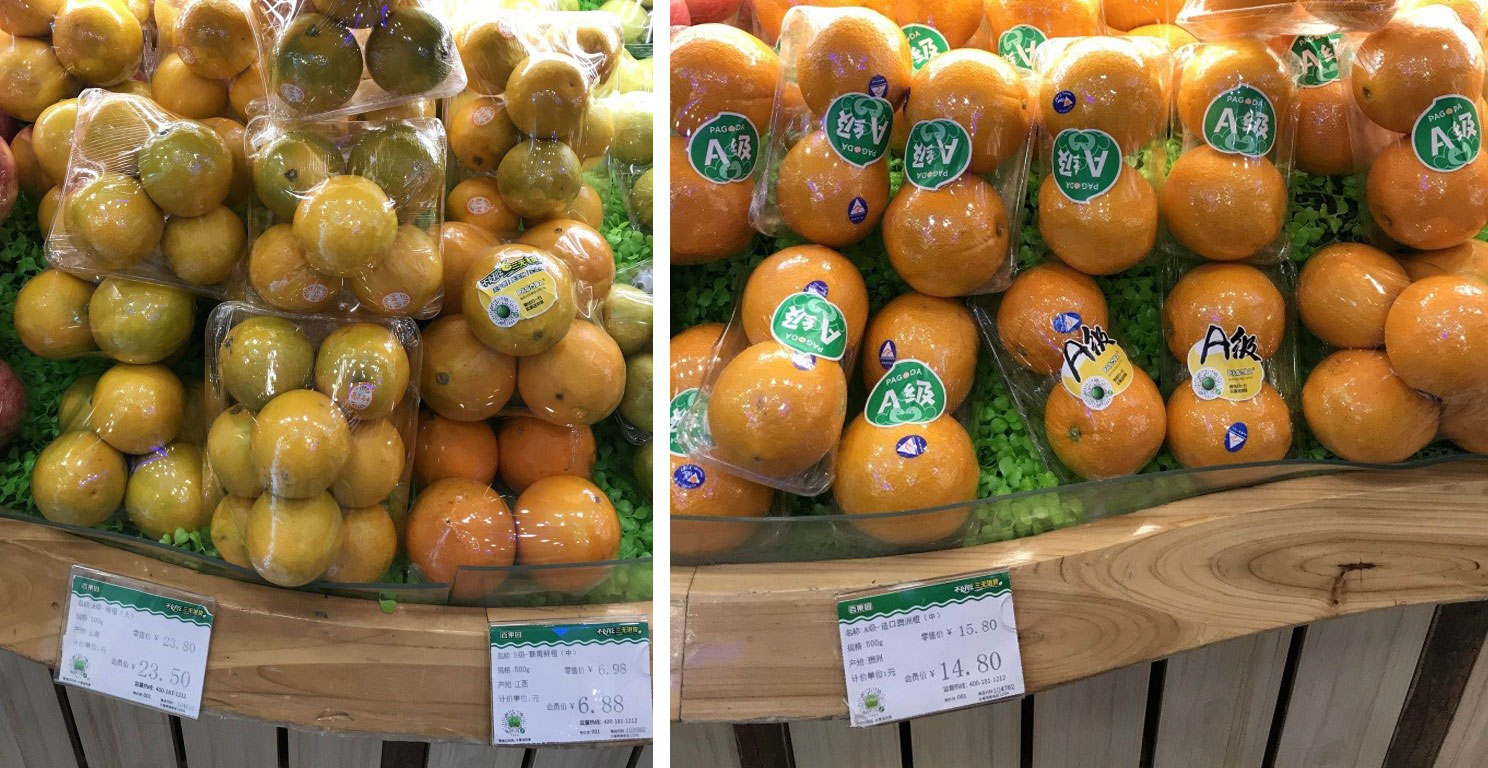
Figure 1. Left: domestic Bintangcheng selling for 23.50 RMB per 500 g ($10.21 AUD/kg). Middle: domestic New Hall navel oranges at 6.88 RMB per 500 g ($2.99 AUD/kg). Right: Australian late navel orange 14.80 RMB per 500 g ($6.43 AUD/kg).
Large domestic Chinese citrus packing houses use inline near infra-red (NIR) quality grading for both Brix and acid to deliver the internal quality specifications that high-end and mid-range Chinese consumers expect (Figure 2).

Figure 2. Left ‘Mr Cheng’ and middle Nongfu Spring ‘17.5o Orange’ are two examples of Chinese orange brands that have guaranteed sweetness. Right: the 5 kg box of Platinum grade ‘17.5° Orange’ brand sold for 138 RMB ($6.00 AUD/kg).
The Australian delegation visited the Nongfu Spring packing shed at Anyayan and also the large Xinfeng factory with a packing line and juice plant. Fruit were electronically sorted to their grades Diamond, Platinum or Gold. Excessively blemished or fruit that did not meet internal quality standards (<10.5o Brix) were processed and blended with Hamlin oranges for juice. Oranges on the packing line had a final visual inspection to ensure fruit matched the specification for each grade. Pack outs vary between seasons. The 2019 season had granulation in the larger sized New Hall navel orange. Generally 5% of fruit were Diamond, 15% Platinum, 40% Gold and 40% juice.
Domestically the brands not guaranteeing internal quality are sold at lower prices and in bulk on-shelf displays (Figure 3).
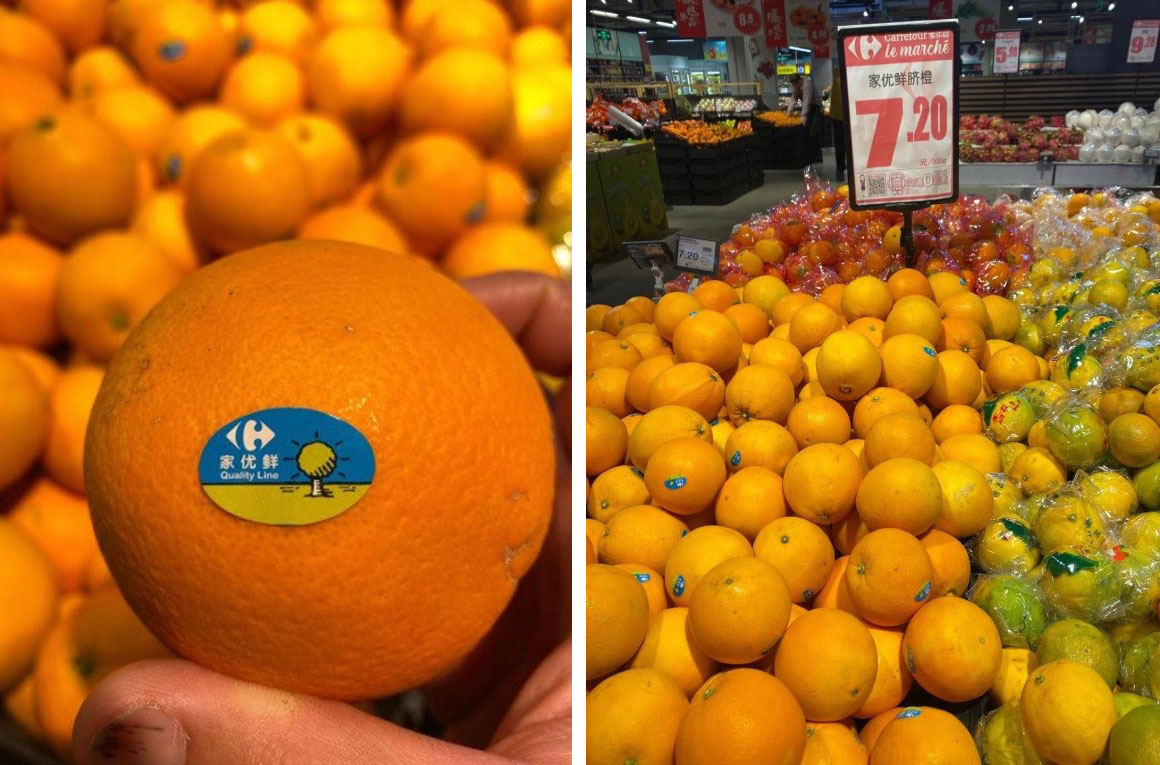
Figure 3: Oranges sold in bulk shelf displays were at lower prices than guaranteed sweet brands. This display was 7.20 RMB for 500 g ($3.13 AUD/kg).
An exception to full coloured fruit was the “Chu Orange”, an early maturing Bintangcheng common orange that is very sweet before full external orange rind colour development. Branded and guaranteed sweet “Chu orange” fruit sold at higher prices than early domestic Newhall navel oranges and also late imported Australian navel oranges (Figure 4).
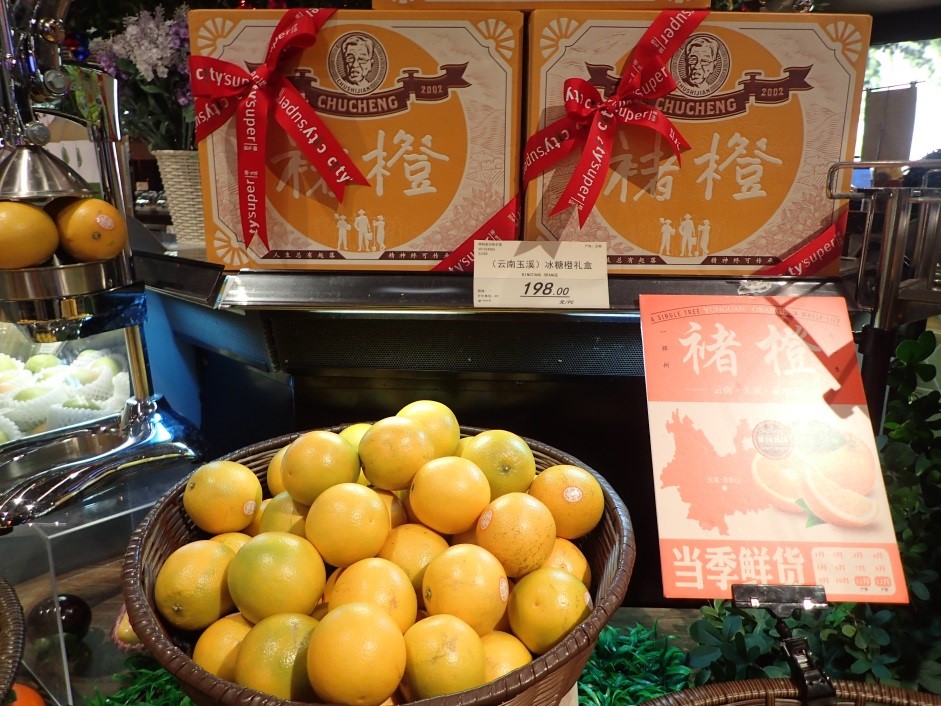
Figure 4: The ‘Chu orange’ retailed for 198 RMB for a 5 kg box ($8.60 AUD/kg).
Chinese retailers and distributors are looking for long term Australian suppliers who can offer consistent quality citrus direct, rather than using the importer. A shared approach to owning the product and promoting it in China is desired, as consumers like to know the story behind their food. A direct Australian packer relation with the Chinese distributor, supermarket or fruit chain is an opportunity for clearer communication from the consumer to the Australian grower. This can help to improve product quality and create a stronger brand.
The China market presently has strong financial returns that are not sustainable unless the Australian citrus product has greater consistency and matches the Chinese consumer’s taste preferences. Imported ‘out of season citrus’ is a discretionary purchase. Consumers only purchase known Australian brands that have delivered fully coloured, sweet, low acid citrus fruit without internal dryness.
Our meetings with fruit chain purchase managers and importers indicated 2PH, Vitor and MFC were known Australian brands. It was noted Australian packers compete amongst themselves with many different brands, however it is unrealistic to expect Australian citrus packers to collaborate and promote a country brand like Chile has done to promote their fruits or New Zealand's Zespri for Kiwi fruit.
A quality regional brand would benefit Riverina growers as the region has a positive story to share with the Chinese consumers. A well-managed and supported quality Riverina brand can help change the perception of the region for lower quality produce. Local businesses can work together to fill orders with a consistent product. The China market is always looking for new brands and new stories.
Discussions with both Shanghai citrus importers (Figure 5) and different fruit purchasing managers from Chinese supermarket chains revealed inconsistent quality, “sometimes sweet and sometimes sour” and also internal dryness were the reasons for Australian fruit imports to cease in 2018 and 2019 for some brands. Citrus importers know citrus from Chile now has market access to China starting in 2020 season. The Chinese consumers will try the cheaper Chilean citrus products offered. Australian growers must demonstrate the value in their product to maintain market share.
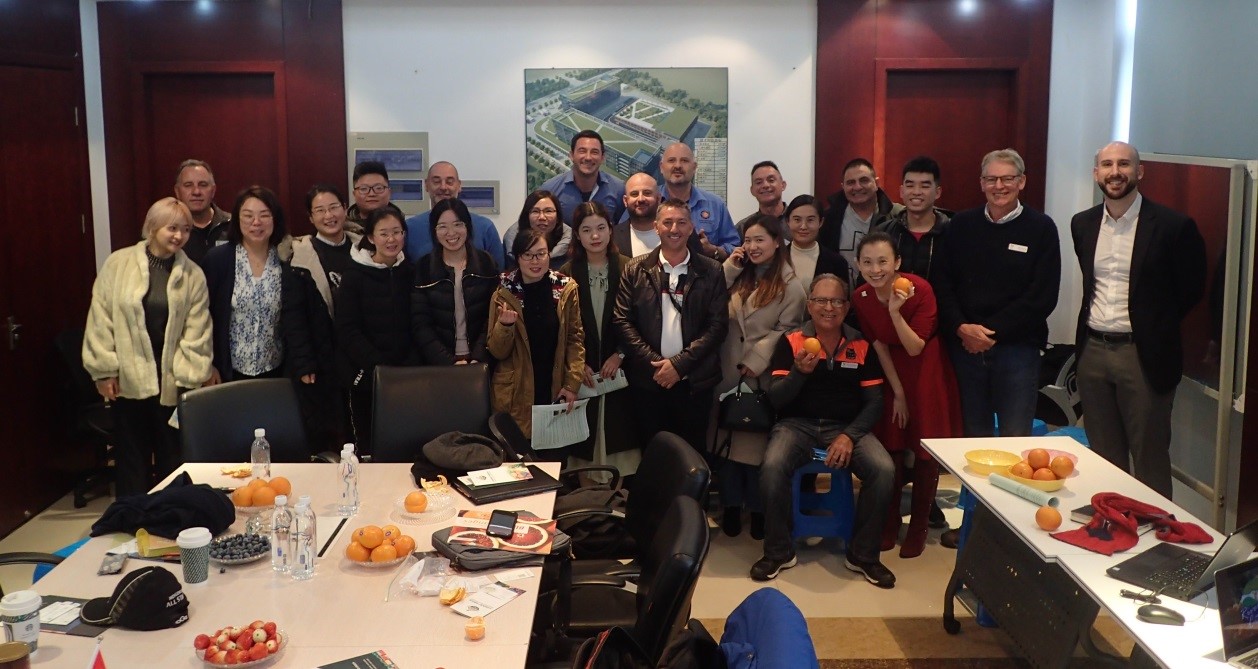
Figure 5: The Australian delegation met with fruit importers at the Shanghai Huizhan Fruit Wholesale Market.
E-commerce or online shopping from the office or home is very popular in the larger cities where imported Australian citrus is sold. In Shanghai, the Australian delegation visited City Super, Pagoda Fruit Chain Stores, City Shop and HeMa Freshippo supermarkets. Each of these had strong sales through their online platforms and also offered the customer a different shopping experience.
For example, Alibaba’s HeMa Freshippo Supermarkets in China offer a modern supermarket experience with café, restaurant and mall-type atmosphere within the store. Customers scan a product with their mobile phone. Prices and detailed information about the product is available, including product origin. Chosen products are selected within the app and customers pay with Alipay at the store exit. The HeMa Freshippo Supermarkets also serve as a distribution centre where staff gather online orders and place them on conveyors that traverse overhead throughout the store to the logistics section for delivery. Delivery is free and within 30 minutes if you are within 3 km of the store.
Visits to Chinese orchards demonstrated the need for strong biosecurity regulation to prevent citrus canker and Huanglongbing (HLB) exotic diseases in Australia (Figure 6). The USA and China have invested heavily in research, seeking sustainable solutions to manage HLB. Currently growers are relying heavily on chemical sprays and are still losing productive citrus orchards to the disease. The chemical program used in China to prevent Asiatic citrus psyllid, (the insect vector of HLB) is not workable in Australia for environmental and economic reasons (Figure 7).

Figure 6: Huanglongbing (HLB) causes tree decline and slow tree death. Leaf symptoms look similar to leaf nutrient deficiency symptoms (left). Affected fruit will be small and bitter and the rind does not develop good colour at maturity. This is commonly known as citrus greening disease (middle). Right: the raised corky lesions of citrus canker on a Newhall navel orange.
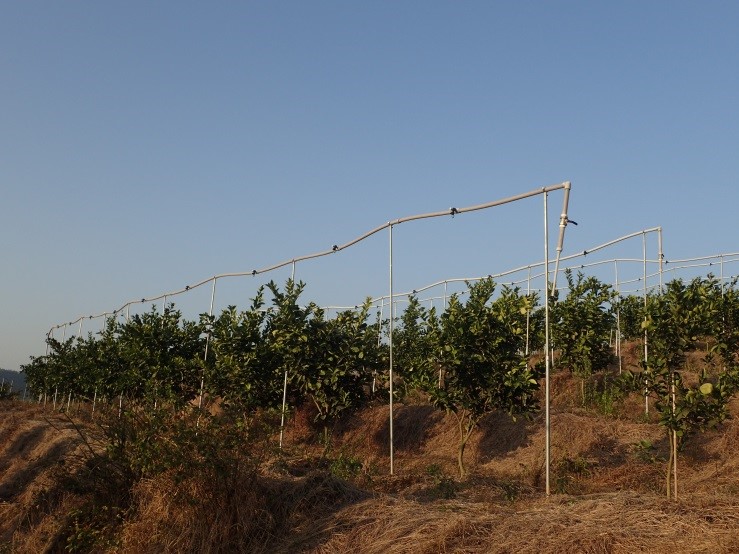
Figure 7. Orchards often had permanent overhead sprinkler systems installed to deliver fungicide and insecticide treatments to manage citrus canker and HLB.
After harvest, different orchards were trenching or excavating beside navel orange trees to apply composted, organic-based fertiliser. The reduction of chemical fertiliser inputs and an increase of soil organic matter improved internal fruit quality by increasing Brix and lowering fruit acidity. A visit to an experimental farm showed very high-density plantings and potential for mechanisation (Figure 8).
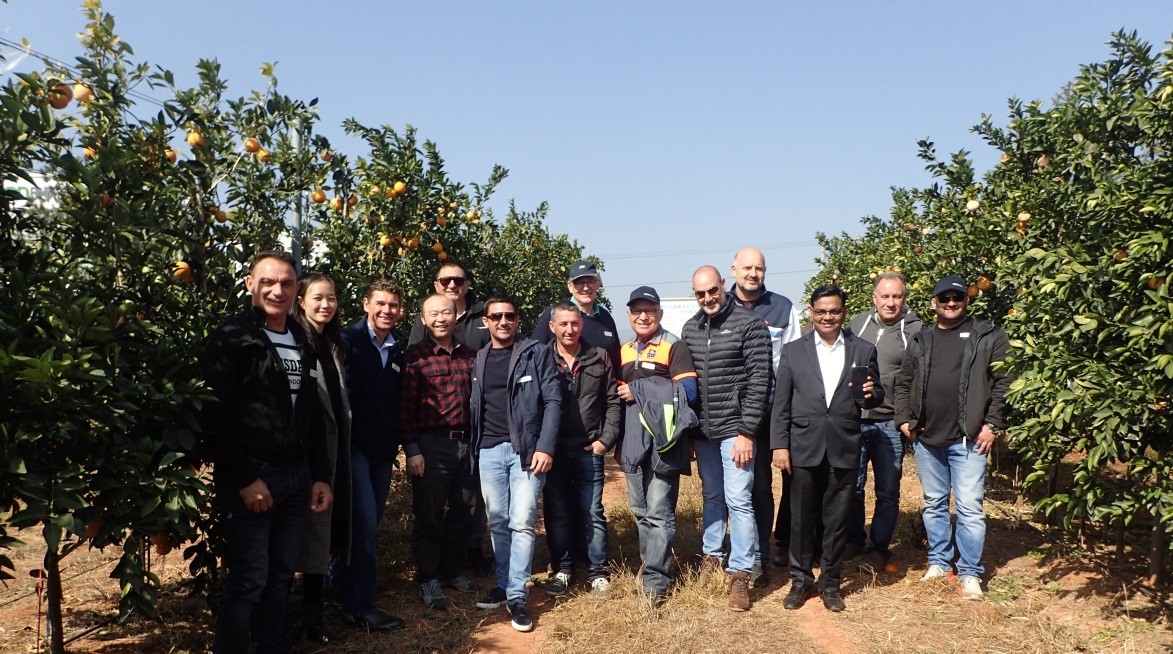
Figure 8: High-density navel orange plantings at Reemoon Technology Holdings research farm.
Acknowledgements
Austrade and their financial support of Griffith and District Citrus Growers Inc. through the Free Trade Agreement Market Entry Grant which has assisted the citrus packers and growers to understand the China market, meet importers and distributors. The study tour has assisted individual businesses to form an entry strategy into the China citrus market.
The NSW DPI International Engagement team assisted the study tour greatly. The delegation appreciated the assistance with itinerary development, tour logistics and translation support while in China. The meetings arranged with many importers and purchasing managers for different fruit distribution channels throughout the tour was invaluable.
Nongfu Spring Co. Ltd. and Reemoon Technology Holdings Co. Ltd. are thanked and acknowledged for generously hosting and supporting the Australian delegation in a citrus production region of China.
Griffith and District Citrus Growers Inc. executive is acknowledged for obtaining the Austrade grant to fund grower participation and also for managing accommodation, meals, bus hire and drivers on behalf of the participants whilst in China.

